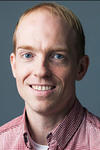Martijn Wieling, Ph.D.
martijn.wieling@haskinslabs.org
Education
2012 PhD., Linguistics
Center for Language and Cognition Groningen, University of Groningen, The Netherlands
2007 MSc, Behavioral Cognitive Neurosciences
University of Groningen, The Netherlands
2007 MSc, Computing Science
University of Groningen, The Netherlands
2005 BSc, Computing Science
University of Groningen, The Netherlands
Research interests
My research focuses on investigating language variation and change. Within this field, I specifically focus on investigating variation in pronunciation using advanced quantitative and statistical techniques. Besides investigating patterns of variation in large digital corpora of text and speech using techniques from computational linguistics, I use experimental approaches to assess differences in movement of the tongue and lips during speech (using electromagnetic articulography). In order to obtain generalizable results, I generally aim to include dozens of speakers in my experimental studies. More information about the projects conducted in my lab can be found at http://www.martijnwieling.nl/lab.
Representative publications:
- Wieling, M., & Tiede, M. (forthcoming: 2017). Quantitative identification of dialect-specific articulatory settings. Journal of the Acoustical Society of America.
In this paper, we show that two distinct Dutch dialects differ in their articulatory settings obtained during pauses in speech.
- Wieling, M., Tomaschek, F, Arnold, D, Tiede, M., Bröker, F, Thiele, S., Wood, S., & Baayen, R.H. (2016). Investigating dialectal differences using articulography. Journal of Phonetics, 59, 122-143.
In this paper we show that two distinct Dutch dialects show a characteristic difference in their tongue position during speech. This is the first time a study has quantitatively shown the presence of such a difference at the dialect level. Furthermore, the study stands out for its large sample size (34 speakers), unique in the field of articulography.
- Wieling, M., Grieve, J., Bouma, G., Fruehwald, J., Coleman, J., & Liberman, M. (2016). Variation and change in the use of hesitation markers in Germanic languages. Language Dynamics and Change, 6(2), 199-234.
In this quantitative linguistics study we show that ‘um’ as a hesitation marker is starting to replace ‘uh’ in various different languages (English, Dutch, German, Norwegian, Danish, Faroese), with women and younger people leading the change. We hypothesize this is caused by the influence of English (with more frequent ‘um’), and ‘um’ being more polite, as the mouth is closed.
- Wieling, M., & Nerbonne, J. (2015). Advances in dialectometry. Annual Review of Linguistics, 1, 243-264.
In this paper (by invitation) we provide a thorough review of how the field of dialectometry has developed in the past decade.
- Wieling, M., Montemagni, S., Nerbonne, J., & Baayen, R.H. (2014). Lexical differences between Tuscan dialects and standard Italian: Accounting for geographic and socio-demographic variation using generalized additive mixed modeling. Language, 90(3), 669-692.
In this paper we effectively merge dialectometry and sociolinguistics by investigating determinants of Tuscan dialect variation, simultaneously including both geography and social factors.
